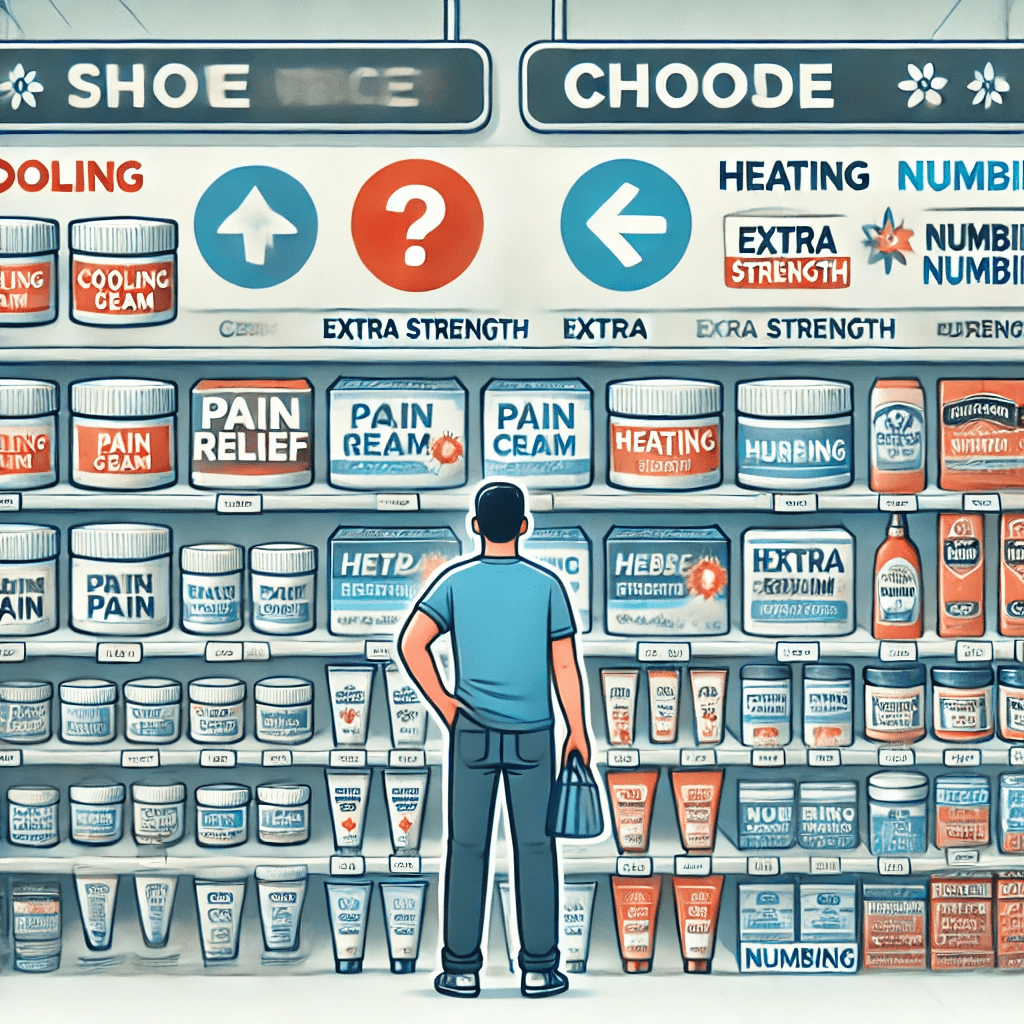Pain relief creams are really helpful for lots of people who have pain from things like arthritis, muscle aches, or injuries from sports. These creams are great because you can put them right where it hurts. This makes them work faster and more directly than pills that you swallow, which have to go through your whole body first.
People use these creams for different reasons, like helping with long-lasting pain from arthritis, easing muscles after working out, or dealing with nerve pain. They’re easy to get and can be used by people of all ages, which makes them really popular.
It’s important to remember that how well these creams work can depend on the type of pain you have, how severe it is, and what your skin is like. They might work really well for one person but not as well for someone else. That’s why it’s a good idea to talk to a doctor to get advice that’s right for you.
Overall, pain relief creams are a handy way to deal with pain. Whether you’re an athlete, someone with ongoing pain, or just need something to help after a tough day, these creams can be a great choice.

Understanding Active Ingredients In Pain Relief Creams
Pain relief creams work because of the special ingredients they have. Knowing what’s in your cream can help you choose the best one for you.
There are natural ingredients like menthol, camphor, and capsaicin. Menthol cools the skin and can distract you from pain. Camphor can cool and warm up areas, helping sore muscles feel better. Capsaicin, from chili peppers, helps by reducing a pain-causing substance in your body. These natural ingredients are liked for working well and having fewer side effects.
There are also synthetic ingredients in many pain relief creams, like NSAIDs, which include ibuprofen or diclofenac. These help by lowering inflammation, which is a common cause of pain. Synthetic ingredients can be really helpful for painful conditions like arthritis that have a lot of inflammation.
Each ingredient works in its own way. NSAIDs are great for joint pain, and menthol is good for muscle pain. It’s important to choose an ingredient that matches the kind of pain you have to get the best effect.
Knowing the difference between natural and synthetic ingredients can help you decide which pain relief cream to choose. Some people like natural options because they usually have fewer side effects, while others might need the stronger effects of synthetic ingredients.
Make sure to read the labels and learn about the ingredients so you can pick the best cream for your pain. If you’re not sure, it’s always a good idea to talk to a healthcare provider for advice.

Formulation Types: Gels, Ointments, and Creams
Pain relief products are available in different forms, each designed to meet specific needs and preferences. Understanding these options can help you choose the best one for your situation.
Gels are mostly water-based, which makes them light and not oily. They soak into the skin quickly, providing a cooling feeling that can be really soothing for sudden injuries like sprains. Because they absorb fast, you might need to apply gels more often to keep getting relief.
Ointments are thicker and oil-based, creating a protective layer that lasts longer on your skin. This can be great for ongoing pain relief. Ointments can also help if you have dry or irritated skin because they’re moisturizing. However, they are greasy, so they might not be the best choice if you need to move around a lot after applying them.
Creams are somewhere between gels and ointments. They mix oil and water to give you a balance of quick absorption with a less oily feel. Creams are good for long-term issues that need regular treatment because they offer steady relief without being too heavy.
Choosing between gels, ointments, and creams usually depends on what feels best for you and what kind of pain you have. If you need quick relief without greasiness, go for a gel. If you need moisture and long-lasting relief, try an ointment. Creams are great for ongoing pain and are less greasy than ointments.
Each type has its advantages and might work better for different lifestyles, types of pain, or skin conditions. If you’re not sure which to choose, trying out a few different types can help you figure out what works best. You can also talk to a healthcare provider to get advice on the best option for your needs.

Mechanisms of Action in Pain Relief Creams
Pain relief creams help ease pain by targeting different parts of the body’s pain system. Knowing how they work can help you choose the best cream for your needs.
One common way these creams help is by blocking pain signals. Ingredients like lidocaine stop the nerves from sending pain messages to the brain. This kind of relief is great for sharp pain from nerve damage or after surgery.
Other creams reduce swelling, which often causes pain. NSAIDs like diclofenac go deep into the skin to calm inflammation, which can soothe pain from arthritis or swelling in the joints.
Some ingredients, like methyl salicylate, boost blood flow to where it hurts. This can ease muscle pain and speed up healing, which is really helpful for sports injuries or sudden muscle strains.
Cooling and warming sensations can also help with pain. Menthol cools the area and distracts from the pain, while capsaicin warms it, reducing the pain signals. These can be good for quick relief from aches in muscles and joints.
Many creams mix these methods to tackle pain from different angles. For example, a cream might cool the pain quickly with menthol and also reduce long-term swelling with an NSAID. This combined approach can be very effective, especially for ongoing pain.
By understanding these different ways pain relief creams work, you can pick one that suits your particular type of pain, whether you need quick relief or ongoing help.

Safety and Side Effects in Pain Relief Creams
Using pain relief creams can really help with aches and pains, but it’s important to use them safely.
Sometimes, creams can make your skin a little red or itchy, especially if your skin is sensitive. Usually, this isn’t a big deal and goes away quickly. Before you use a lot of the cream, try a little bit on a small part of your skin to see how it reacts.
It’s also important not to use too much cream. If you put on too much, it can absorb too deeply and make you feel sick or dizzy, especially if the cream has strong stuff like NSAIDs or capsaicin.
Some people, like pregnant women, moms who are breastfeeding, or people taking other medicines, should talk to a doctor before using these creams because certain ingredients might not be good for them.
After you apply the cream, wash your hands well, especially if the cream has ingredients like capsaicin or menthol that can sting if they touch your eyes or nose. Some people like to wear gloves when they put on the cream to keep it off their hands.
Keep your pain relief creams in a safe place where kids and pets can’t get to them, and store them in a cool, dry spot to keep them working well.
If the cream makes your skin hurt, itch a lot, or if you get a rash, stop using it and talk to a doctor right away. Always put your safety first when you’re using these creams to help with pain.

Prescription vs. Over-the-Counter Options
Choosing the right pain relief cream involves deciding between over-the-counter (OTC) and prescription options, each with its own benefits.
OTC pain relief creams are easy to get. You can find them in pharmacies, grocery stores, or online. They often contain ingredients like menthol, camphor, and lower doses of NSAIDs, which are good for mild to moderate pain. Most people can use these creams safely without needing to see a doctor first.
But sometimes, OTC creams aren’t strong enough, especially for severe or ongoing pain, like bad arthritis or nerve pain. This is when prescription creams might be needed. These have higher levels of active ingredients or special compounds made just for your pain needs. They’re usually more effective because they’re stronger.
It’s important to talk to a doctor if you’re thinking about prescription creams. They can check your pain and suggest the best cream with the right strength. Prescription creams might cost more and need a doctor’s visit, but they can really help with tough pain.
When picking a cream, think about how well it works, how easy it is to get, and how much it costs. If you have serious, constant pain that doesn’t get better with OTC creams, a prescription cream might be best. If your pain is less severe or doesn’t happen often, an OTC cream might be enough. Always ask your doctor for advice to make sure you choose the best cream for your situation.

Patient Experiences and Testimonials
Real-life experiences with pain relief creams can offer valuable insights. Hearing from others who have used these products can help you set realistic expectations and even guide your choices.
Many people find that pain relief creams offer quick and convenient relief. For instance, athletes recovering from injuries often prefer topical treatments because they can apply them directly to sore muscles without affecting their entire system. They’ve shared stories of faster recovery times and fewer side effects compared to oral medications.
Chronic pain sufferers, like those with arthritis or fibromyalgia, often turn to pain relief creams for their ability to provide localized relief. Many have reported a noticeable reduction in pain levels and improved daily functioning. Personal testimonials often highlight how a specific product made it easier for them to perform everyday tasks, like walking or holding objects, without discomfort.
It’s also helpful to look at case studies. These are detailed reports from medical professionals that document how a particular cream worked for someone with specific pain conditions. Case studies can provide more in-depth information about the effectiveness and safety of different formulations.
However, it’s important to remember that not everyone will have the same experience. Skin types, pain types, and other factors can influence how well a cream works for you. Keep this in mind when reading reviews and testimonials.
If a particular cream interests you, discussing it with your healthcare provider can offer additional insights. They can help interpret patient experiences in the context of your specific medical condition, ensuring you make the most informed choice.

Emerging Trends and Innovations
The world of pain relief creams is always changing as scientists work to make them better and more effective. It’s important to keep up with these changes to find the best solutions for pain relief.
Scientists are creating stronger ingredients from plants and other natural sources that help ease pain without many side effects. These new ingredients are chosen for their high quality and effectiveness.
Technology is also improving pain relief creams. For example, nanotechnology helps the ingredients reach deeper into your body where the pain is, making the creams work better. Some creams now slowly release medicine over time, which is really helpful for people who have pain all the time.
Being kind to the environment is becoming popular too. Many companies are making creams with safe, natural ingredients and using packaging that’s good for the Earth. This is great for people who care about the planet.
Personalized pain relief is also becoming a thing. This means creams are made specifically for one person’s pain, making them more effective. These special creams are made to meet the exact needs of someone’s pain.
By knowing about these new ideas and talking to your doctor, you can find the best and newest pain relief cream for your needs.

Choosing the Right Pain Relief Cream for You
Choosing the right pain relief cream means thinking carefully about what you need. It’s not as simple as just picking any cream off the shelf. First, figure out what kind of pain you have. Is your muscle sore, or is it a joint that hurts? Maybe it’s nerve pain? Different creams are made to help with different kinds of pain, so it’s important to know exactly what you’re trying to treat.
Next, look at what’s in the cream—the active ingredients. Some ingredients are better for certain pains than others. If you’re not sure which one is right for your pain, or if you have a long-term pain issue, it’s a good idea to talk to a doctor or another healthcare provider. They can help you choose the best cream with the right ingredients to help you feel better. This way, you can be sure you’re getting a cream that really addresses your specific pain needs.
Considerations..
When choosing a pain relief product, you have to think about the best type for your needs. Gels are great if you want something that sinks in fast and doesn’t leave your skin feeling oily. They’re perfect for when you need quick relief without the mess. If you’re looking for something that stays on longer and keeps working, then an ointment might be what you need. It sticks around and keeps soothing your pain. Creams are right in the middle—they absorb well but aren’t too heavy. This makes them a good choice for all kinds of situations, whether you need help with a sore back or a stiff knee.
Pay attention to potential side effects and safety measures.
Before you start using a new pain relief cream, it’s really important to make sure it’s a good match for your skin and health history. Trying a little bit of the cream on a small part of your skin, like a patch test, helps you see if your skin likes it or not. If you’re not sure or if you have special health needs, talking to a doctor or a nurse about it is a smart move. They can help you figure out if this cream is safe for you to use, so you don’t end up with any itchy or annoying skin reactions. This way, you can use the cream safely and feel better knowing it’s right for you!
Personal testimonials and patient experiences can also be valuable.
Listening to what others say about a pain relief cream can help you understand how well it works. But remember, what works for one person might not work the same way for another.
It’s also good to keep up with new things in the world of pain relief creams. There are always new ingredients and technologies being discovered that might help you feel better more efficiently. Being open to trying new things can help you manage your pain better.
In the end, finding the best pain relief cream depends on what you need, getting advice from experts, and knowing about the latest in pain relief. Taking the time to figure out what works for you will help you make the best choice.
Concluding Thoughts on Choosing Pain Relief Creams:
Choosing the right pain relief cream is like picking the perfect tool to help you feel better, whether you’re dealing with a sports injury, chronic pain, or just some stiffness from a long day. Each cream is designed to target different kinds of pain, so understanding what each one does, checking the ingredients, and thinking about the cream’s form can help you find the best match for your needs.
It’s important to remember that what works for one person might not work for you. That’s why it’s great to hear from others about what they’ve tried and to stay updated on new products that might work even better. Always keep your own health in mind, and chat with doctors to make sure you choose a safe and effective cream.
Finding the right cream might take some time and testing. But with the right information and advice, you can make smart choices that improve how you manage your pain and boost your overall happiness. The goal is to find a cream that helps you heal and keeps you comfortable, so you can enjoy your favorite activities without pain getting in the way.

